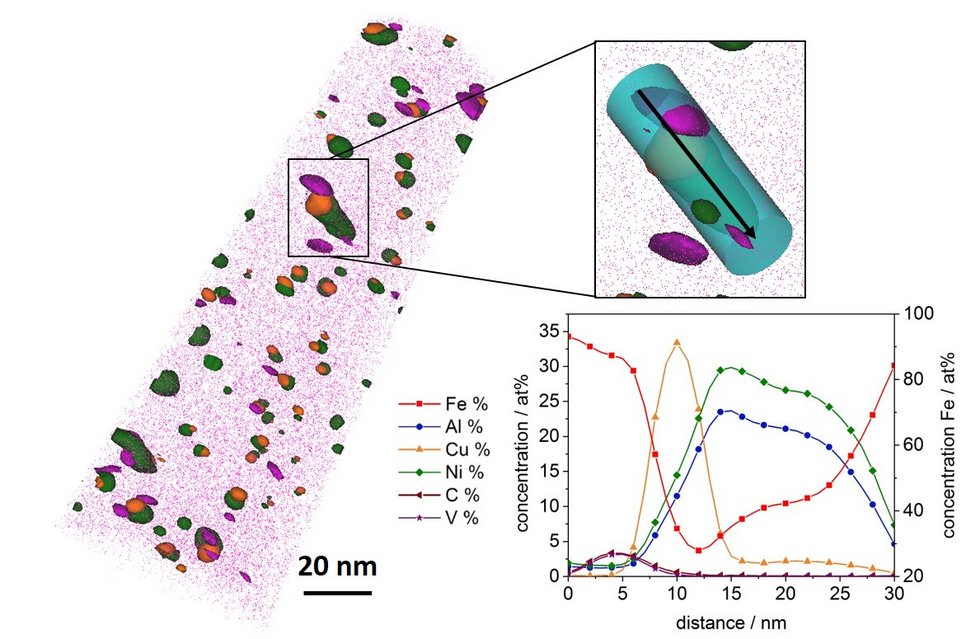Design and Development of steels of the 21st century – starting from the atomic structure
With about 1.6 billion tons produced per year, steel is still the most important construction material. Research and development of novel high performance steels will significantly contribute to the key subjects of the 21st century, such as sustainability, reduction of CO2 emissions, energy saving and recycling. The objectives of the research group are development of new and optimization of existing high performance steels, for which an integrative approach including new alloying concepts for steels and their energy-efficient production is adopted. In addition, the existing applications in the automotive industry, the energy conversion and distribution as well as traffic and transportation are taken into account. Regarding the automotive industry, the trend towards lightweight construction with an additional increase in personal safety are the driving forces for the development of new advanced high strength steels. Strength and toughness should be increased at the same time, and hence push the limits of the technological capabilities as far as possible. For applications with such requirements, new steels with improved chemical, physical and mechanical properties are necessary. Therefore, comprehensive knowledge of the metallurgical manufacturing processes, the processing procedures such as forging and rolling, the alloy design, the structure-property relationship as well as the actual applications of steels is required.
Application example: Investigation of the atomic structure of high performance materials
Atom probe tomography is one of the methods with the highest resolution which can be applied for developing and gaining understanding of modern high performance materials (see Figure 1). Thereby, it is possible to examine materials at the very atomic level, which considerably contributes to the understanding of the structure-property relationship and is indispensable for the development of new steels. Figure 2 depicts an exemplary result of an atom probe measurement. A special attention has to be paid to the lengthscale lying in the nanometer range (1 nm = 10-6 mm). Each red dot represents a single detected Fe atom. The blue spherical particles visualize precipitates in the material, which are in this case enriched in Ni and Al. A precise alloy design allows to control the number, the particle density, distance and chemical composition of these precipitates. These directly influence the mechanical properties, such as tensile strength and elongation of the steel. Thus, the properties and applicability of materials can be tailored using knowledge and modification of the atomic structure.
The steel design shall be supported by the use of simulation and modeling tools which will be applied in addition to experimental and analytical methods. This requires a strong interdisciplinary cooperation of the new Chair with other materials-related Departments and Chairs of the Montanuniversität Leoben. The research activities of the new Chair should contribute to the achievement, reinforcement and expansion of the technological leadership of the domestic steel producing and processing companies and ensure production sites in Austria. Although the Montanuniversität already possesses state-of-the-art equipment for materials characterization, additional investments in characterization techniques particularly suitable for steel research are planned in the framework of this endowed professorship. The newly founded Chair receives funds through the FFG, the industry and the Montanuniversität Leoben. One of the most important cooperation partners from the industrial side is the leading Austrian steel-based company voestalpine.
Design, Development and Characterization of Advanced High Strength Steels (AHSS)
Fuel saving and safety aspects are the driving forces behind the steadily increasing use of high-strength steels in the automotive industry. Research is currently being conducted on the third generation of Advanced High Strength Steels, where a significant amount of retained austenite is stabilized by carbon redistribution in a martensitic or bainitic matrix. Under load, the metastable retained austenite transforms into martensite, thus increasing the formability. This effect is deployed in the production of components with complex geometry or in the event of a crash to absorb energy. A basic understanding of the relationship between chemical composition, heat treatment, microstructure and mechanical properties is essential to further improve the performance of these high strength steels.
A promising heat treatment concept of the third generation Advanced High Strength Steels is the so-called "Quenching and Partitioning" (Q&P). After austenitization, the steel is quenched to a temperature between martensite start and finish temperature to generate a defined fraction of martensite. In a second step, the carbon is redistributed from the supersaturated martensite into the remaining austenite, thereby stabilizing it. In order to gain a basic understanding of the relationship between heat treatment, phase evolution and carbon redistribution, in-situ heat treatments were carried out in the synchrotron at DESY in Hamburg. Recording the diffraction patterns during the entire heat treatment cycle enables a time-resolved determination of the phase fractions and their carbon content. These findings were subsequently correlated with the mechanical properties and provide the basis for optimizing the heat treatment parameters.
Design, Development and Characterization of high-alloyed steels
High-alloyed steels can be divided into the two groups of corrosion-resistant and tool steels, whereby the latter can be subdivided into cold work tool steels, hot work tool steels and high speed steels. Accordingly, there is a very broad field of applications of these steel groups, which ranges for example from household goods via plastic mould steels to forging dies, mills and drillers for machining. The alloy design, especially the carbon content, is essential for fulfilling the required mechanical properties such as wear resistant, toughness or creep resistance.
The aim of the research group is to reveal the structure-property relationships and the establishment of a deep understanding of the microstructure of these high-alloyed steels in order to lay the foundations for optimizations and new product developments. This should allow more efficient solution as well as reveal new fields of application.
In the field of high-alloyed tool steels, a method for the determination of the thermo-mechanical fatigue strength was evaluated, which is now successfully used for the testing of steels. This property is connected with the microstructure of dual hardening steels, which are used as plastic mould steels. Therefore, the precipitates and carbides are characterized by atom probe tomography. An exemplary measurement is shown in the figure below.






